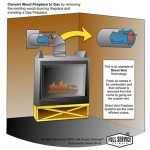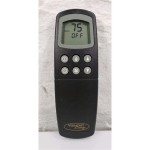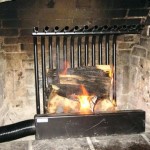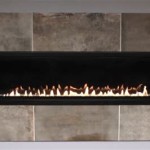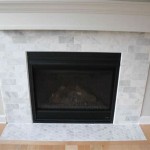Putting a Wood Stove Inside Your Fireplace: A Comprehensive Guide
The practice of installing a wood stove within an existing fireplace is a common method for enhancing heating efficiency and improving the overall aesthetics of a home. This approach leverages the existing chimney infrastructure, reducing the need for extensive renovations while offering a more controlled and efficient heating source than an open fireplace. However, successful installation requires careful planning, adherence to safety regulations, and a thorough understanding of the components involved.
A traditional open fireplace, while aesthetically pleasing, suffers from significant heat loss. A large proportion of the heat generated escapes directly up the chimney, making it an inefficient heating source. Furthermore, open fireplaces require constant tending and can pose safety risks due to uncontrolled sparks and embers. A wood stove, on the other hand, is a closed combustion appliance designed for optimal heat output and fuel efficiency. By placing a wood stove inside a fireplace, one can retain a degree of the traditional fireplace ambiance while significantly improving heating performance and safety.
This article will explore the considerations involved in installing a wood stove inside a fireplace, covering aspects such as stove selection, safety requirements, installation procedures, and the potential benefits and drawbacks of this approach.
Key Point 1: Assessing Compatibility and Safety
Before proceeding with the installation of a wood stove inside a fireplace, thorough assessment of compatibility and safety is crucial. This involves evaluating the fireplace structure, chimney condition, and compliance with local building codes and regulations.
The fireplace structure must be inspected for structural integrity. Cracks, loose bricks, or deteriorated mortar can compromise the safety of the installation. If damage is present, repairs are necessary before proceeding. The firebox should be large enough to accommodate the wood stove with adequate clearances; insufficient space can lead to overheating and potential fire hazards. Consult the wood stove manufacturer's specifications for minimum clearance requirements.
The condition of the chimney is paramount. A malfunctioning or damaged chimney can lead to dangerous carbon monoxide buildup and increased fire risk. A professional chimney sweep should inspect the chimney flue for obstructions, creosote buildup, and structural defects. Creosote, a byproduct of incomplete combustion, is highly flammable and can cause chimney fires. If significant creosote buildup is present, the chimney must be cleaned before installing the wood stove.
Building codes and regulations regarding wood stove installations vary depending on location. It is essential to contact local authorities to determine specific requirements, including permits, inspection procedures, and emissions standards. Failure to comply with these regulations can result in fines and potential safety hazards.
Furthermore, consider the existing hearth. The hearth must be non-combustible and extend far enough beyond the fireplace opening to protect the flooring from sparks and embers. If the existing hearth is insufficient, it may need to be extended or replaced.
Key Point 2: Wood Stove Selection and Installation
Choosing the appropriate wood stove for installation within a fireplace requires careful consideration of several factors, including heating needs, fireplace dimensions, and desired features. Proper installation is essential for safe and efficient operation.
Selecting the correct size wood stove is crucial for optimal heating performance. A stove that is too small will not adequately heat the space, while a stove that is too large can lead to overheating and inefficient fuel consumption. Calculate the heating needs based on the square footage of the area to be heated and the climate. Consult the wood stove manufacturer's specifications for recommended heating area ranges for different models.
Consider the type of wood stove to be installed. Options include catalytic and non-catalytic stoves. Catalytic stoves use a catalytic combustor to burn off gases and particles, resulting in cleaner emissions and higher efficiency. Non-catalytic stoves rely on advanced combustion designs to achieve cleaner burning. The choice depends on personal preferences and local emissions regulations.
Installation typically involves several steps. First, the wood stove is positioned within the fireplace opening, ensuring adequate clearances from combustible materials. A connector pipe, also known as a stovepipe, is then used to connect the stove to the chimney flue. The stovepipe must be of the correct diameter and material, typically single-wall or double-wall steel, and installed with proper clearances to reduce the risk of fire.
A crucial step in the installation process is connecting the stovepipe to the chimney flue. This can be achieved using a direct connection to the flue liner or by using a chimney liner. A chimney liner is a stainless steel or ceramic pipe that runs the entire length of the chimney, providing a smooth and consistent surface for the exhaust gases to flow through. Using a chimney liner is highly recommended, as it improves draft, reduces creosote buildup, and protects the chimney structure from corrosion. Installation of a chimney liner typically requires professional assistance.
After the stove is installed, it should be thoroughly tested to ensure proper operation. Check for smoke leaks, ensure adequate draft, and monitor the stove's temperature to prevent overheating. A carbon monoxide detector should be installed in the room to provide early warning of any potential carbon monoxide leaks.
Key Point 3: Venting and Chimney Considerations
Proper venting is absolutely essential for the safe and efficient operation of a wood stove installed inside a fireplace. The chimney serves as the primary conduit for exhausting combustion gases, and its condition and configuration significantly impact stove performance and safety.
As previously emphasized, the existing chimney should be thoroughly inspected and cleaned before connecting a wood stove. Any obstructions or damage must be addressed to ensure proper draft. The chimney flue should be sized appropriately for the wood stove; an undersized flue can restrict airflow and lead to smoke spillage, while an oversized flue can result in poor draft and increased creosote buildup.
The use of a chimney liner is highly recommended to improve venting efficiency and protect the chimney structure. A properly sized and installed chimney liner provides a smooth and consistent flue surface, reducing friction and promoting optimal draft. It also prevents combustion gases from seeping through cracks in the chimney masonry, which can lead to carbon monoxide leaks.
When connecting the wood stove to the chimney, ensure a tight and secure connection. Use appropriate connectors and sealants to prevent smoke leaks. The stovepipe should be installed with a slight upward slope to promote proper draft and prevent condensation from running back into the stove.
Consider the height of the chimney. The chimney should extend at least three feet above the highest point of the roof and at least two feet higher than any part of the building within ten feet. Insufficient chimney height can lead to poor draft and smoke spillage.
Regular maintenance of the chimney is essential to ensure continued safe and efficient operation. The chimney should be inspected and cleaned annually by a qualified chimney sweep to remove creosote buildup and identify any potential problems. Neglecting chimney maintenance can significantly increase the risk of chimney fires and carbon monoxide poisoning.
In summary, installing a wood stove inside a fireplace can be an effective way to improve heating efficiency and enhance the ambiance of a home. However, careful planning, adherence to safety regulations, and proper installation are crucial for a successful and safe installation. Thorough assessment of the fireplace and chimney, selection of an appropriate wood stove, and attention to venting and chimney considerations are essential steps in the process. Regular maintenance is also necessary to ensure continued safe and efficient operation.

Can You Install A Wood Stove In Fireplace Direct Stoves

Converting A Fireplace To Wood Burning Stove Chesneys

How To Install A Wood Burning Stove Into An Existing Fireplace

Can You Install A Wood Burning Stove In An Existing Fireplace

Converting A Fireplace To Wood Burning Stove Chesneys

Can You Install A Wood Stove In Fireplace Direct Stoves

Can You Install A Wood Burning Stove In An Existing Fireplace

Can You Install A Wood Stove In Fireplace Direct Stoves

Fireplace Inserts The Cure For Cold Fireplaces Jøtul

Can I Put A Wood Stove In My Fireplace
Related Posts


